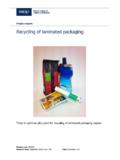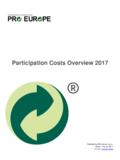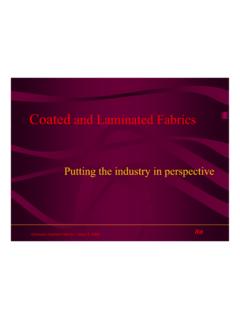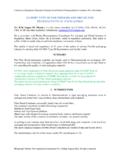Transcription of 24 Food Packaging Wastes and Environmental Impacts
1 24) food Packaging Wastes AND Environmental Impacts . 1. INTRODUCTION. The rise in Environmental consciousness in recent decades has included a focus on household waste . It is not the most urgent of the problems we face, but it may be the most immediately accessible. Global climate change, the destruction of the rain forests, and disasters such as Chernobyl and Bhopal are far away and hard for an individual to influence; but garbage disposal happens again and again, right at home under our personal control. Those who seek to act on their Environmental concerns, therefore, often find it easiest to begin with the problems of solid waste .
2 When a 1990 Gallup poll asked people in the United States what they had done in connection with Environmental problems, 80% to 85% answered that they or their households had participated in various aspects of recycling; no other significant steps had been taken by a majority of respondents Packaging has come to symbolize the issue of waste . It represents roughly one -third of municipal waste in the United States. It has expanded rapidly in recent times; most adults today remember growing up in a world that used much less Packaging . Perhaps most important of all, Packaging feels wasteful: used once and then promptly discarded, it seems like only an ephemeral presence in our lives as it rushes from factory to landfill.
3 Yet Packaging remains ubiquitous; it is impossible to imagine an urban, industrial society functioning without it. Since the first packages were created well over 10,000 years ago, Packaging has served many important purposes: To contain. To carry. To protect. To preserve. To make a product look so enticing that it simply must be bought. Modern Packaging has made life easier in many ways: food preparation and storage, longer shelf life for products, frozen foods, processed foods, takeout foods. Unfortunately, such convenience has come at an Environmental price. 2. SOURCES. tonnes of the 26m tonnes of the household waste produced annually is Packaging .
4 150m tonnes of Packaging waste come from industry and commerce each year. To achieve a change towards more sustainable Packaging , it's not just the Packaging that requires alterations but also our lifestyles and habits of consumption. People in the US throw away plastic bottles every hour and less than 3% are recycled. In the UK: of the 15m plastic bottles used every day, much less than 3% gets recycled. Less than 1% of the billions of plastic bags used each year are recycled and the majority are used only once. European law wants us to recover 50% of all our Packaging and to recycle 25%. 3. WHY WE NEED Packaging ?
5 Most of the things we use at home and at work are produced somewhere else so that they have to travel to get to us. Consumers benefit from packages because they protect products as they travel, whether fast food or refrigerators, no matter how far they have to go. A well-designed package is attractive and appealing to consumers, and inspires confidence of product safety. In addition, A. Packaging provides a physic al barrier between a product and the external environment thereby ensuring hygiene and reducing the risk of product wastage due to contamination. B. Some forms of Packaging prolong the life of food .
6 Paper 24 PAGE 1/5. C. Some Packaging is also needed for safe and efficient transportation. D. Packaging is also used to provide customers with information and instructions, for which there are some legal requirements. 4. TYPES. The most common types of material used for Packaging are paper, fiberboard, plastic, glass, steel and aluminum. A. Paper: One of the most widely used Packaging materials, particularly corrugated cardboard used for transport Packaging . The current recycling rate for paper and board Packaging waste is 49%. B. Glass: is the most common form of Packaging waste . Glass can be returned and re- used or recycled easily and a well-established recovery and recycling system exists in the UK.
7 The first bottle-bank in the UK appeared in 1977 and today there are over 20,000. Six billion glass containers are used annually in the UK and the recycling rate is 22%. C. Aluminum: is used in many Packaging applications such as beverage cans, foils and laminates. It has a high value as a scrap metal with prices ranging from 650-750. pounds per tonne and can be recycled economically. Of the estimated 5 billion aluminum cans consumed in the UK in 1996, 31% were recycled. D. Steel: is a widely used Packaging material for food , paint and beverage as well as aerosols. Recycling steel brings significant resource and energy savings.
8 The current recycling rate for steel cans is 16%. E. Plastic: offers several advantages over other Packaging materials in its sturdiness and low weight. Even though plastic can be recycled there is a lack of facilities in the UK. The current recycling rate for plastic in the UK is 5%, with the remainder either land filled or incinerated. F. Mixed materials: Packaging can sometimes have the benefits of being more resource and energy efficient than single material Packaging , but combining materials makes recycling difficult. Recycling these materials is hindered by the lack of facilities and technology necessary to separate materials to avoid contamination.
9 Mixed materials Packaging can be reprocessed into other products such as floor coverings, shoe soles and car mats, incinerated to produce energy, or land filled. 5. Environmental Impacts . Choice of Packaging type is made on the basis of a series of trade -offs between many factors, particularly between the amount of Packaging and likely product wastage. Consumers are increasingly willing to buy concentrated products in lightweight refill packs for dilution at home. Does the package thickness matter? Packaging materials differ in thickness. The thinner the Packaging material, the less landfill space it will take up.
10 Thin plastics can be very strong. Some manufacturers have addressed the Packaging dilemma by switching to strong, thin materials for wrapping such items as disposable diapers and dinner napkins. However, the use of thinner plastics in food Packaging can reduce safety and protection from contaminants, punctures, and tampering. Paper 24 PAGE 2/5. Why are packages layered? Sometimes two or three materials are combined or laminated together to keep foods safe and fresh. However, commingled materials are difficult to recycle. For example, drink boxes have six layers of polyethylene, foil, and paper. Each layer is necessary to preserve the drink.






